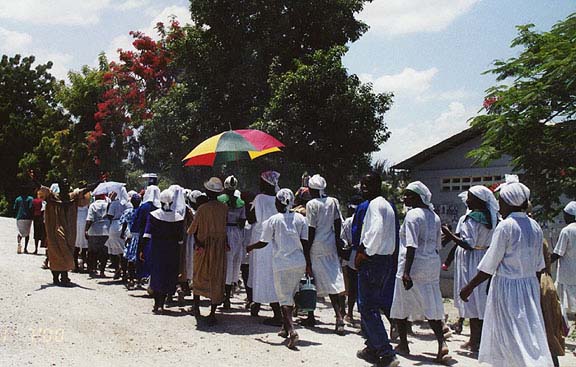
Peace Corps works with Organization for the Rehabilitation of the Environment in Haiti
David Doherty, Peace Corps in Haiti
David Doherty is a refugee from all things functional or organized. In other words, he is a Peace Corps volunteer serving in Haiti.
Monday | Tuesday | Wednesday
Wednesday, 10 Dec 2003
CAMP PERRIN, Haiti.
Haitian proverb: Nanpwen maladi li pa gen remed.
"There is no illness that doesn't have a remedy."
The hills are alive! Not all of Haiti is dead and brown.
I finished eating my breakfast of tuna fish and crackers while chatting with the mechanics at the office of ORE, Organization for the Rehabilitation of the Environment. As I searched for someplace to dispose of the empty tuna can, Anzou directed me to toss it over a nearby fence. It was a not-so-subtle reminder that I'm in Haiti.
ORE is a Haitian NGO that was founded on the premise that farmers will not cut down trees if their value in fruit production exceeds their value for wood products. Starting with funding from the Canadian Embassy in 1986, the three principals of ORE -- British professional photographer Sean Finnigan, his Haitian physician wife Mousson, and a U.S.-educated Haitian agronomist Eliassaint Magloire (a relative of Haitian President Paul Magloire, who was forced out of office by "Papa Doc" Duvalier) -- introduced top-grafting to Haiti. Coupled with traditional techniques, they brought commercial-grade grafted fruit trees to Haiti.
The Madame Francique mango is now one of the chief sources of income for farmers in the south of Haiti. In addition, out-of-season avocados, mandarin oranges, clementines, carambola (star fruit), and tangelos have created new wealth for farming families. Through later funding from U.S. AID and the European Union, ORE was able to expand their programs to include mini-setting (for plantains, yams, etc.) and hybrid-seed development for staple crops.
As no good deed shall go unpunished, funding dried up just as the various programs were poised to make their greatest impact. In the words of the director of one of Haiti's largest donors, "The south [of Haiti] is relatively prosperous; we must direct our monies to areas with the greatest need." On one hand, the logic is incontrovertible: Health and nutrition programs are vital initiatives if one wants to avoid a catastrophic collapse of this country. On the other hand, feeding programs destabilize the local agricultural base (farmers can't compete with free food), thus decreasing food security. And on the third hand, if one is allowed a bit of tri-dexterity, is it a good idea to walk away from a region just as it is starting to turn the corner?
ORE will cease to function as a viable force to mitigate deforestation and the disappearance of water sources if they do not receive new funding by March of 2004. The Global Environment Fund as administered by the United Nations Development Program may be our last, best chance to secure adequate support to continue the regional trend toward increased tree cover. Spring preservation and expanded tree cultivation are vital components of protecting the future for this part of Haiti.
Thus, Sean and I find ourselves locked away in a secure facility pondering the what-ifs and the why-fors as we write up a funding proposal. More than a mere academic exercise, the goal is to convince the powers that be to invest in a region of Haiti that has the best chance to become productive on a large scale. (In the world of international aid, the word "sustainable" has become verboten as the only thing that has been sustained in most underdeveloped countries is the need to keep pumping in good money after bad.) It's time to abandon the Band-Aid approach to development.
